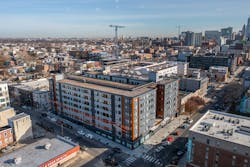Volumetric Building Companies (VBC) Uses Holistic Approach to Modular
After Katerra shut down last year, Fast Company asked, “If Katerra can’t make it, can any prefab company?” Katerra had been one of the largest prefabrication construction companies, with billions of dollars in investment.
Volumetric Building Companies (VBC) is one modular company that’s already made it, says CEO Vaughan Buckley. Industry experts agree: In May, VBC won the construction and design category for the Ivory Prize, which honors ambitious and scalable solutions to housing affordability. The Philadelphia-based company provides “high-quality, sustainably produced buildings in less time,” said the prize announcement.
Buckley founded VBC as a general contractor in 2009. Since then, VBC has evolved into a full-service manufacturing company, providing developers with turnkey modular solutions. Between 2015 and 2020, the company saw 2,000% growth. In 2021, VBC acquired Katerra’s assets, including its manufacturing facility in California.
This year, VBC expanded beyond the U.S. when its equity partner, PIMCO, acquired a Polish modular construction company called Polcom. That merger gave VBC the resources to deliver high-rise hospitality projects internationally.
Volumetric Building Companies Delivers Award-Winning Modular Construction
In factories in the US and Poland, VBC produces multifamily housing, student housing, affordable housing, hotels, and hospitality projects for developers on the East Coast and West Coast, as well as Europe and the Middle East. Over the past decade, VBC has built about 5,000 modules.
What separates VBC from the competition, Buckley explains, is this: Other modular manufacturers, particularly in multifamily and hospitality, tend to focus on manufacturing modules built for planned packages. That leaves their client developers having to find and manage the architects, the trucking companies, the installers, and the general contractors. “From a risk-mitigation perspective and cost perspective, it’s not the most efficient way to produce modular buildings,” Buckley says.
VBC, by contrast, handles all of that work in-house. It designs, manufactures, transports, and installs modular buildings. “The end result is we can have a more accurate, more predictable, and much higher-quality product with lower cost and faster delivery,” Buckley says.
VBC projects realize 40% to 60% time savings compared to site-built projects that were constructed in the same areas and times. VBC’s cost savings are not as significant but not negligible either, ranging from 5% to 10%.
"It’s not a huge swing in cost that our clients typically seek modular for. It’s the reduction in schedule, which allows them to substantially increase the volumes of buildings they produce." — Vaughan Buckley, CEO, Volumetric Building Companies
VBC’s multifamily clients move in their tenants a year or sometimes two years earlier than they would with traditional builds, he adds.
By providing full-service architecture and engineering services, VBC can efficiently manage the entire modular process, start to finish. “The biggest impact you can have on cost is design,” he says. “If you begin at design, you have a better opportunity to control and predict cost throughout the process.”
VBC ANALYZES AND OPTIMIZES ITS EFFICIENCY
To evaluate its modular designs, VBC uses a simple metric it calls the modular optimization score—which is simply the number of a project’s modules divided by the number of its module types. A higher score means that VBC is building more modules with more replication and less variation. In other words, the higher the score, the greater the efficiency.
To justify taking a manufacturing approach on a project, VBC wants to have a minimum score of 2 to 4. But it’s been able to get its modular optimization score all the way up to 18 to 20.
VBC achieves that by identifying design efficiencies upfront. For instance, one building project might involve mirror-reversed units: one with a balcony on the left, the other with a balcony on the right. That potentially would require two different module types with two different types of each component, such as the doors. Instead, VBC could design just one module type and get the same mirror-reversed effect by simply rotating it 180 degrees, which would halve the number of required components.
“The fewer times you change to a new module type, the fewer errors you’re going to see and the higher quality you’re going to get,” Buckley says.
VBC’s holistic approach also enables it to mitigate what Buckley calls “the riskiest part” of modular construction projects: transportation and logistics. That’s owing to the many different people involved in transport, including the trucking company, crane company, general contractor, roofer, and local regulatory authorities such as police and oversize/overweight escorts. That’s a lot of stakeholders (and contracts) that can impact the project.
Transportation also carries a weather risk. A traditional construction site gets exposed to all weather. But when a VBC module leaves the factory, it’s 90% finished. If a module isn’t properly sealed and installed, rain doesn’t fall on an unfinished shell—it can damage drywall, kitchen cabinets, and other finished components.
VBC also hasn’t been immune to supply chain challenges, with delays in the delivery of components. “It costs more, is the short answer,” Buckley says. VBC orders earlier and has more inventory on hand, and its clients sometimes have to be flexible and accept substitutions based on market availability.
But VBC, which employs about 560 people, hasn’t experienced the construction industry’s labor challenges, Buckley says. The company partners with local schools and training programs in its locations, and it also provides apprenticeship programs and months-long training programs, sometimes bringing on people without any construction experience and turning them into trade professionals. “We find treating employees well results in good retention,” Buckley says.


